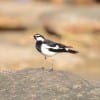 by Jim Stevenson
by Jim Stevenson
Here is the information for our annual GOS sale, which keeps us afloat. I have never said this in 19 years, but we have some serious financial emergencies this year, like needing a new van, and your generosity has never been more needed and appreciated. Please take the two minutes required to look over this entire document. Calendars have over 200 of my pictures, plus important GOS dates (and national holidays, stuff like FeatherFest, etc.).
My book, Birdlife of Galveston is $40, and feel free to tell me how to inscribe it, if you wish.
My six other books are on sale for $10 each, and the two bird courses I created on disk have been reduced to $40 EACH. [Described below]
TAKE YOUR TIME DECIDING WHAT YOU WANT! THERE’S NO HURRY!
Here are the simple instructions and please take the thirty seconds to read it carefully! IT HAS CHANGED SINCE LAST YEAR!
1) Pick out what you want from below and e-mail it to me WITH YOUR NAME and MAILING ADDRESSDO NOT SEND A CHECK before you receive your goods! Many of your e-mails don’t have your name, so PLEASE place it with your order!
2) The bill will be on the FRONT OF YOUR PACKAGE and YOU WILL ADD THE POSTAGE TO YOUR TOTAL AMOUNT.
3) Upon receipt of the merchandise, please send a check to the return address, GOS, Rt. 1 Box 185C, Galveston, TX, 77554. Yes, I trust you. Now see below…
Thank you for your generosity, allowing us to survive now for 19 years. We charge NO dues, you don’t have to attend any trips and I am at your service 365 days/year for help with bird matters. Or jokes.
Items for sale by the GOS
2015 Calendars: $20 each; $75 for 5; $100 for 10.
Anyone wishing past calendars may purchase them for $5 just for the bird pictures. 2009-2114
Jim’s Books: Collection of four- $25 (book titles below) All signed. Or $10 ea. (please specify which one)
Wildlife of North Florida
Jamaica, Queen of the Air (fictional account of a Red-tailed Hawk)
Birds and Mammals of Alaska
Quest for 5000 Birds (Jim’s world travels to see 5000 species)
Bird Classes on CD: Learn all about Birds with Jim’s PDF classes!
Each daily lesson comes with pictures of birds discussed. Below:
Birding A2Z- 200 lessons on the Life History of Birds: Ecology, Plumage, Migration, Reproduction and much more. A steal for $40.
Birding A2Z2 – 100 lessons on identification of North American Birds. Not recommended for West Coast birding. $40
OK, so enjoy these Aussie birds…
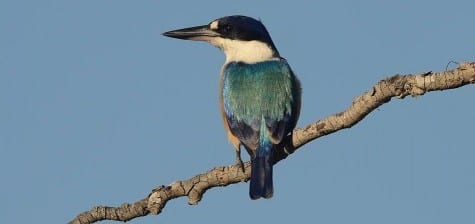
Forest Kingfishers are largely terrestrial birds but are still plentiful around the water as well. They are easily Australia’s most abundant kingfisher and are smart-looking and tame. Many kingfishers (and our bluebirds and buntings) may have some camouflage advantage against the sky with their blue colors.
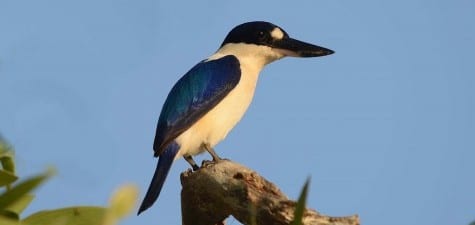
Forest Kingfishers are easily recognized with the white spot in front ofthe eye, and the bill is rather terrestrial; large enough to handle snakes and other land animals that might come along. They are a hop, skip and jump from kookaburra. I’ve been teaching birds a long time and this family has always been among the most favorite of all groups.
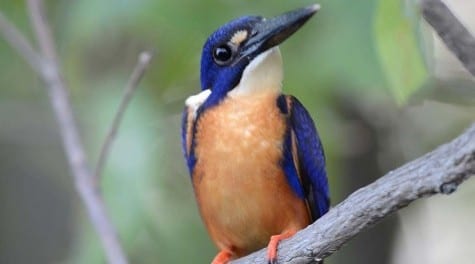
A smaller, entirely aquatic member is the Azure Kingfisher, reminiscent of some of the smaller kingfishers of Tropical America. They are very often seen in shady places (their moms never warned them about) and the large eyes allows them to see fish in those dark spots I might add that these are hard spots to shoot in, with little light.
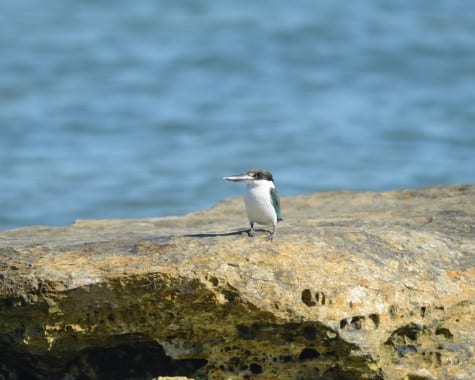
No problem with light with the White-collared Kingfisher, a largish, marine fish-killer. It is easily found in many coastal areas of northern Australia, and I’ve always gotten them at Nightcliff, near Darwin. Curiously, they are about as tame (not) as Belted Kingfishers, while most others in the Old and New World are very approachable.
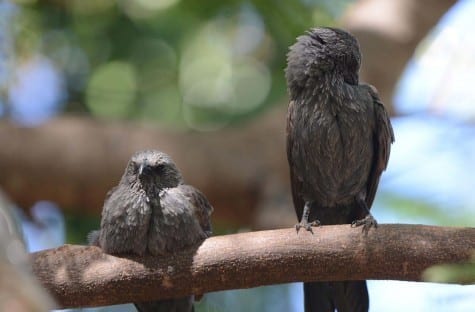
Apostlebirds are kinda grackle-ani in appearance, but it’s surprisingly hard to get them out in the sun. The edge of the shade is almost a barrier they won’t cross! Among song¬birds (I willgenerously call them that) theypreen and debug themselves amazingly often and occasionally allopreen. This is said to form community bonds, although I would be hesitant to perform thisservice for my Island friends.
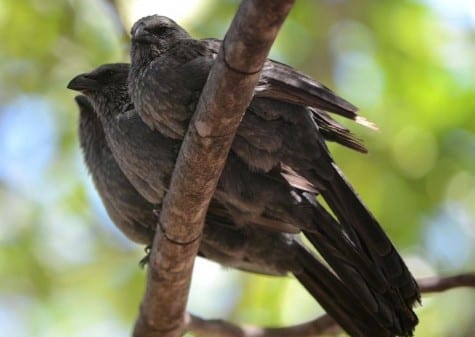
These Apostlebirds were caught in the act allopreening, but my presence seemed to scare them, or shame them into stopping. Something about eating bugs off your friends… This is a common species in lazy little towns in the Outback, where even the small store is a welcomed surprise. I will always remember those little towns like Georgetown with a lot of fondness. I’ll miss being out back.
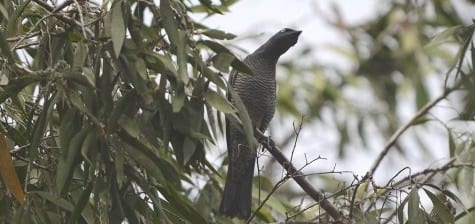
A crappy picture of a rare bird is this Barred Cuckoo-shrike, one of only two I have ever seen. Most leave Australia in fall and winter in places such as New Guinea, returning in August to begin the breeding season. Cuckoos & their relatives are certainly interesting birds and many are seen only once or twice on our trips.
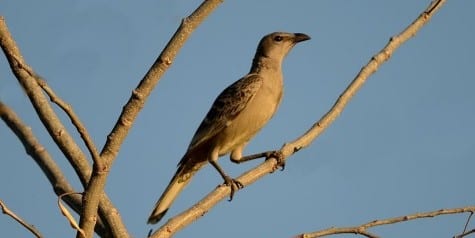
Much easier to find than their relatives is the Great Bowerbird, a common resident of the Tableland communities and small towns of the Outback. This family is well known for the males creating “bowers” for the females they court, lined with colorful trinkets and such they steal from people, or curious rocks and other prizes from the natural world. This habits are very well known by the Aussies and the local bower is as well.
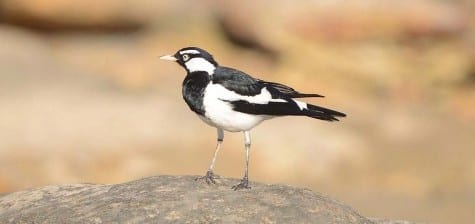
Pied Larks are very common in Australia, named for their black&white colors. They are mostly in the lowlands, often along sidewalks, getting ridiculously tame around people. In fact, it’s a little hard to get a picture of one without the annoying wire or sidewalk in the shot. There are nine birds with “pied” in their name and four “magpie,” showing how many Aussie birds are black and white. I wonder why!
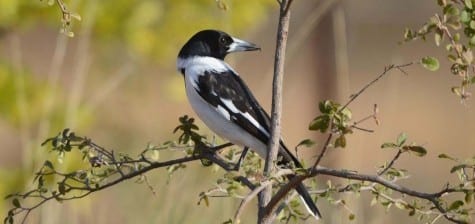
Well, there ya go. This is the Pied Butcherbird, one of the shrike-like killers found around the Continent. The hook on the beak surely reminds you of shrikes and it servesthe same gruesome purpose. I tried in vane getting decent shots of my favorite, Black Butcherbird, which hides in the shade and gives little in the way of photo ops.
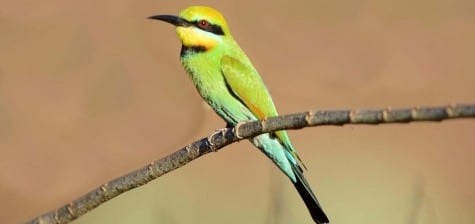
No such problem with the Rainbow Bee-eater, agaudy and friendly bug-hunter found all over Aussie Land. Their black mask says, “hunter,” and the long bill is used effectively for grabbing and beating bees on limbs. Bee-eaters are Old World and Africa really has the corner on the market on them, especially the magnificent Carmine Bee-eater.
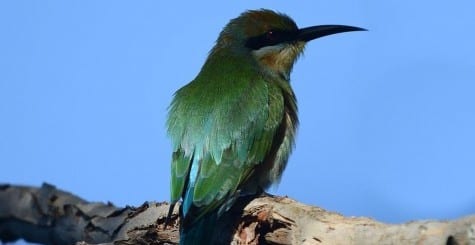
From the back, they are also nice-looking.

I found a few species like myna to be roosters, but I never expected to find a roost of bee-eaters! They were in Townsville, right along the coastline. By my count there are 15, and I suspect there were over 200 in the entire patch of trees. I’d like to learn more about the roosting behavior of birds, advantages and disadvantages, in time.
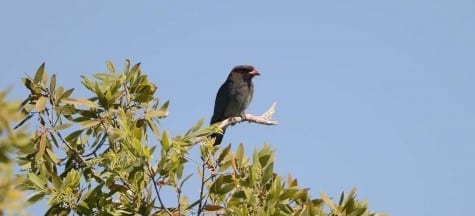
This was my first Dollarbird! They are a summer resident in Australia, which makes Hell look chilly. The stocky, square-headed shape of this species is hard to miss (dare I say to “pass the buck”), and they are quite the omnivore. Many of these birds leave Australia in the winter, but it’s not the temperatures so much as lessened food, like bugs in the arid winter, when insectivores would feel, well, hapless. ~inside joke
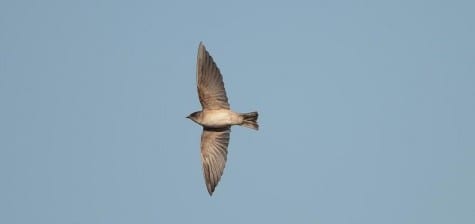
Tree Martins are one of several mini-groups of swallows common in Australia, and they seem to have little trouble finding bugs on which to dine. Swallows are great fliers and the wings show they are built for speed and alacrity. This species isn’t very common but we found one lake with hundreds of them feeding, making me think there was a hatching.
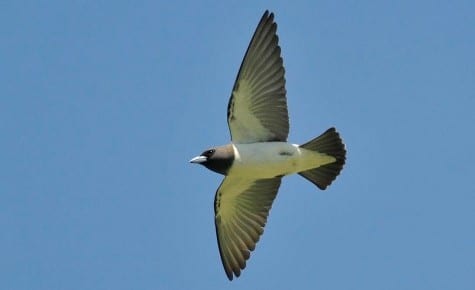
Related to Tree Martins are wood-swallows, with about a half-dozen roaming Aussie air space. The bill tells you they also eat fruit – which we saw – so they are omnivores. The swallows we have in the US are more related to Aussie tree martins than these birds seen above. Wood-swallows are not found anywhere in the New World.
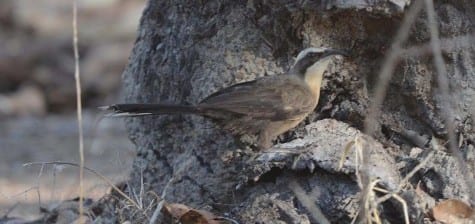
Babblers are very social, vocal birds that move through areas in small groups, making all kinds of calls. They are another group that will allopreen each other, while just sitting around, talking about what bugs them. They often feed a bit thrasher-like, reminding me of the thrashers of the Desert Southwest (maybe because that’s the next trip I run).
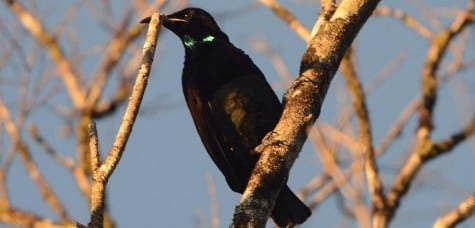
Victoria’s Riflebird is found up the eastern mountains and can be easily observed around the sleepy town of Paluma (just north of Townsville). It’s really a bonanza coz it also has Green Catbirds, Satin Bowerbirds and pittas in town, plus Chinchilla in the neighboring woods. Many residents leave fruit out for their magnificent birds.
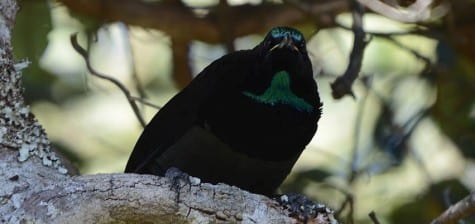
Here’s another male riflebird, showing off its blue.
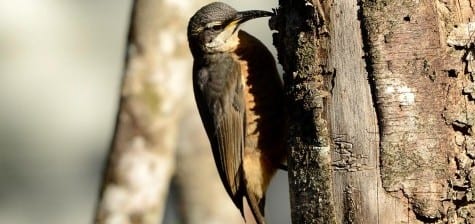
The female riflebird is using its long, decurved bill to get into the bark for grubs. There are no woodpeckers in Australia, so the bark-working niche is open to unrelated birds like riflebirds. Obviously, they lack the tail of the woodpecker, and use their bill a bit different than the hammer of woodpeckers
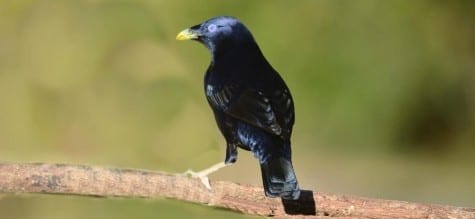
Male Satin Bowerbirds are deep blue, and like other bowerbirds, they have a special place where they show off their treasures to visiting females, sometimes having the honor of fathering their young. The feathers and sheen are neat enough, but the blue eyes just spellbound onlookers.
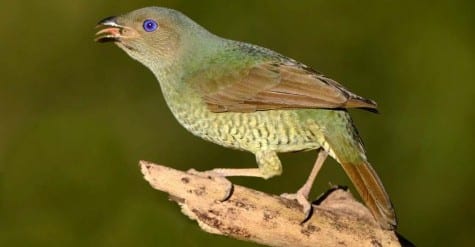
With the same eyes as the male, female Satin Bowerbirds actually resemble catbirds quite a bit. The bill tells you they are frugivorous, although they eat more insects while eggs are developing, and feed their young insects for the protein for growth. Like tanagers and many others, they wind up eating bugs themselves at that time, just for convenience.
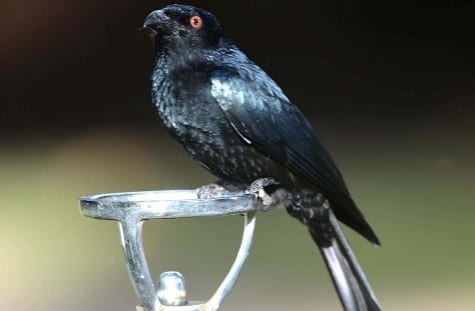
The Spangled Drongo has no fear of people or populated areas, and just sits around waiting for some poor bug to fly by. The red eyes (presumably) allows it to function in very dark areas (deep shade), and there are other insectivores around the World that have those same eyes.
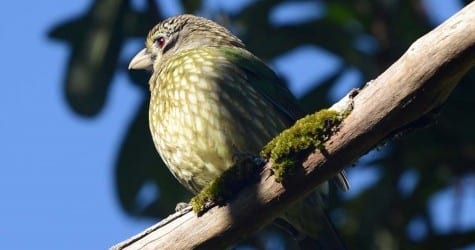
Here is the Green Catbird, not a great picture but a very cool bird. They are named such because their calls are very cat-like, but I have learned that certain of the friarbirds also make these down slurred, whiny notes. Catbirds can actually be very tame and abiding, but this trip I had a devil of a time getting a good shot. Speaking of voices, these Torresian Crows and Australian Ravens as well make whiny calls about the same quality (or lack thereof) as the Fish Crows back East. It’s an “uh¬ohhhhhhh,” that terribly amusing. Of course, the white eyes of these birds also set them apart from all-black crows on other continents, and is a cool look.
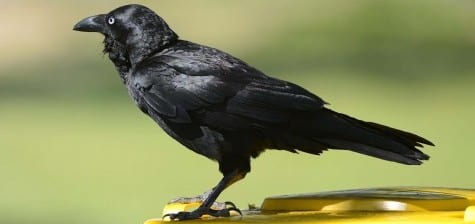
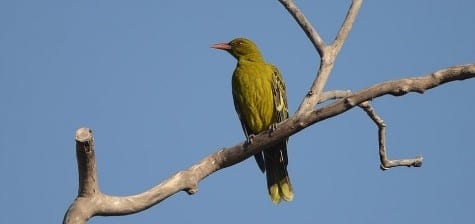
Yellow Orioles are more green, really, and also have neat calls that are similar to some friarbird vocalizations. They are often pretty secretive in the thick woods but this one get caught out in the open. The orioles of Australia lack the orange we see so frequently on our orioles, and also fail to produce musical songs or calls.
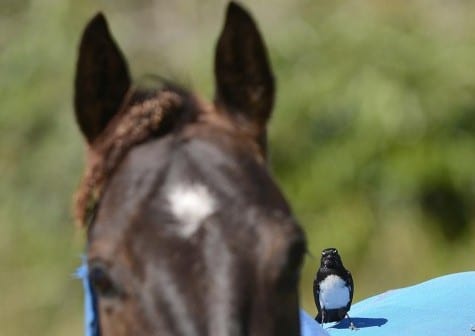
My favorite Aussie bird is easily Willie Wagtail, the black and white flycatcher that’s part Black Phoebe and the rest unknown. Here he’s horsing around, looking for flies and riding the horse’s, well, hindquarters. ~This could get to be a nightmare by dark.~ Many insectivorous birds hang around livestock until they pony up some flying lunch.
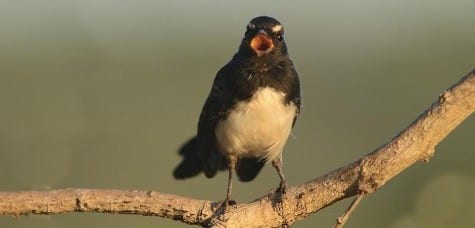
Willie is not very happy with me, and I was unable to explain his disdain until I looked into the corner of the tiny building over the water. He and the missus had built a nest and two little wiggletails were snuggled up, awaiting their nest bug-meal. ~Hap, are you still there? ~Note a flesh-colored inner mouth color of the adult. Young have a yellow-orange color which apparently helps the adult see the target for the next meal.
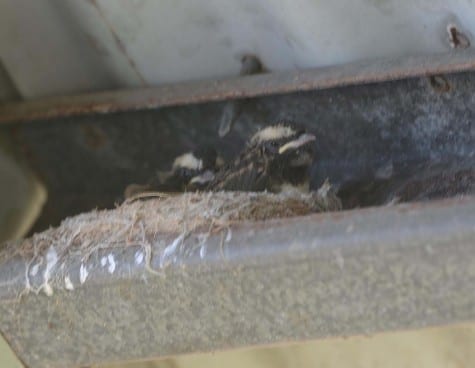
It was awfully dark for a picture, but here are the twins laying low while I futzed (Ciona, is that the right word?) with my camera’s settings. You can already see the white stripe over the eyes, and the large, flat flycatcher bill. Remember, it was the disappearing Willie Wagtail in the 60s that served as a call-to-arms and mobilized the Aussies to end the use of DDT. Well, good on them!

 Posted in
Posted in 























